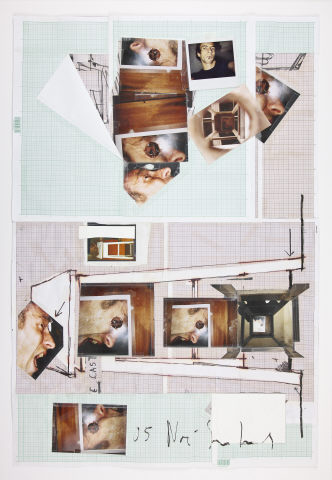
Noé Sendas
Eye Cast (Study)
Brussels, Belgium, 1972
Beyond the academy, his training has been developed through ongoing research into the creative processes of other artists, punctuated by artist residencies in various countries as a recipient of grants from such institutions as the Calouste Gulbenkian Foundation, the Camões Institute and the Peggy Guggenheim Museum. These were important periods in his development, introducing him to specific themes that would inspire some of his most emblematic series of works, such as German Diaries (2009-2012), based on the homonymous work by Samuel Beckett.
In his first works, made in the late 1990s (City Thoughts, 1996-97; Ophelia, 1997-2003), a system based on references is already evident, in that a re-reading of indisputable artists within Western art history becomes associated with recurring allusions to literature (Shakespeare, Joyce) and to cinema (Fassbinder, Fellini, Hitchcock, Godard).
Sendas’s double interest in the printed and the moving image leads him to choose photography and video as critical media for building and documenting a journey that also incorporates drawing, collage, sculpture and installation. By manipulating the image, Noé Sendas questions notions of identity and authorship, attributing other meanings to pre-existing works. In Pursuit, Left Running (2000), the artist alters the original rhythm and employs a loop to indefinitely prolong a segment of Akira Kurosawa’s film Drunken Angel.
In turning to photography as a field for experimenting with the metamorphoses of images, the artist recovers surrealist techniques (collage, superimposition) and updates them with digital technologies, allowing some of their aspects to be removed and remade. On the other hand, he manipulates the printing method as if he were producing photographs from that era, raising doubts about time and authorship, a strategy especially visible in the series Crystal Girls (since 2009).
By transforming collected and serialised images, Noé Sendas creates galleries of ambiguous portraits that can be read as reproductions of works of art from museums, self-portraits of the artist or reflections of the spectator. Eye Cast (2004) eloquently expresses this play of mirroring, at once literal and metaphorical, in which images brought together by the artist intersect with the observer’s projection. The mirror, which first emerged in his earliest works, including Numb Mirror (1996) or Lady Macbeth (2003), represents the eternal inquiry into an image’s variations and the phenomenology of recognition, in which is inscribed the idea of the double, an extension of the author in the presence of the spectator.
Restlessness, discomfort and strangeness are the transversal markers of his work, regardless of the media used. In his sculptures, hyperreal figures replicate the artist’s body in stagings with a clear theatrical inclination. These are figures that evoke misencounters and improbable stories of characters in search of an author in a time suspended between irony, terror and abandonment. Initially conceived in the wake of the video Wanderer (1997-99), The Rest is Silence II (2003) expresses a desire to create narrators in disconcerting situations, referencing the tragedy of Hamlet’s last words and the long silences in the meetings between James Joyce and Samuel Beckett.
The idea of the double or the alter ego takes on a new meaning when the artist also assumes the roles of collector and gallery owner (The Collector, 2007), dismantling the phenomena of influence, rupture and continuity between authors. At its limit, Noé Sendas extends his inquiry into the creative process to his own work, examining it as if he were looking at another artist’s work (Processo: Quem é Noé Sendas?, 2010). Proof of the self-referential aspect of his work, or paradoxically, of the literary distancing that he manages to establish with respect to himself, this method confirms his fascination for the imprecise, intermediate terrain lying between I and other that we find in the poetry of Mário de Sá-Carneiro.
Noé Sendas’s singularity in the landscape of Portuguese art over the past few decades is due in large part to the way in which he has been able to trace a coherent path, with his solid conceptual foundation and distinctive rhythm, oblivious to the superficial fluctuations of the current day. In his more recent works, one can perceive the increasing value placed on the notion of the system rather than on the object. A system that goes beyond the realm of installation when it seeks to describe the genesis of a work, its predecessors and its contextual implications, while proposing spatial relations between objects. Work, exposition and installation constitute an indivisible concept in which each piece requires and describes a museography of the whole, according to a process in which the artist controls even the smallest detail.
Noé Sendas lives and works in Madrid and in Berlin, where he and five other artists founded the artist-run space Invaliden1.
Helena Barranha
April 2013